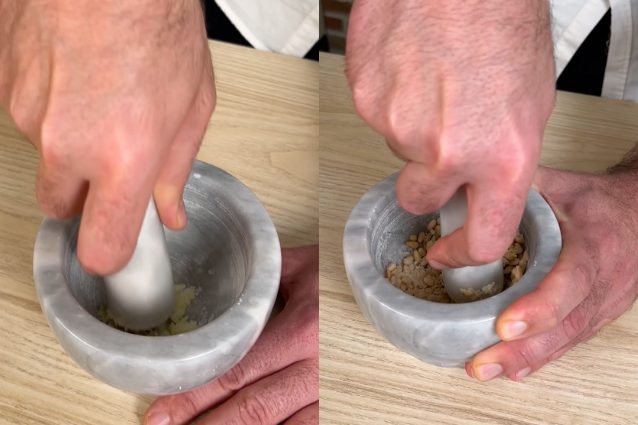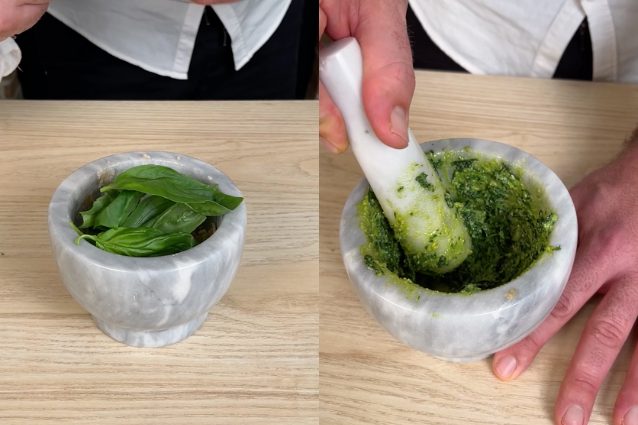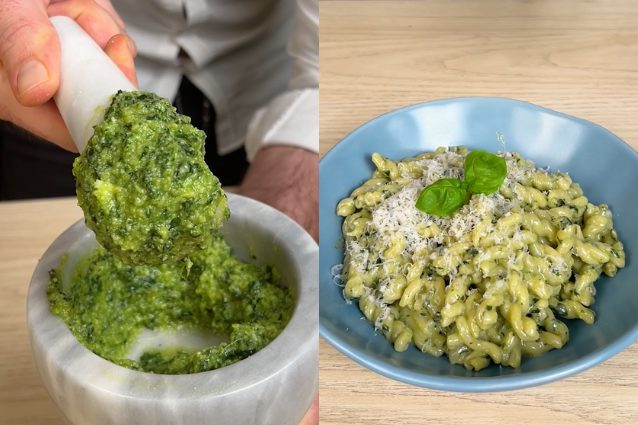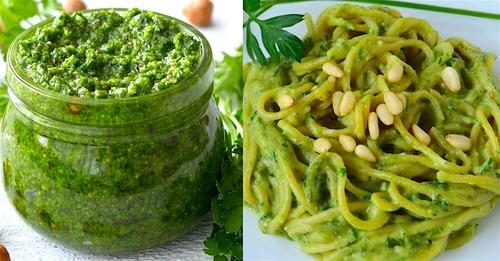
Authentic Italian Pesto: the Recipe for the Traditional and Homemade Pesto Genovese!

Make the most of your homegrown herb garden by making basil pesto. This simple Italian recipe is an excellent way to use a fresh crop of basil. Pesto is a wonderful, versatile sauce you can use as a pasta dressing, sandwich spread, pizza sauce, or even marinade.
With its mouthwatering herby, garlicky flavor and bright green color, pesto livens up just about any savory dish. If you have loads of fresh basil on hand, plus some garlic, parmesan, pine nuts, and olive oil in your kitchen, you can whip up a quick batch of homemade pesto in no time. It's a great make-ahead recipe you can freeze and use any time of year! You won't buy the store-bought pesto anymore.
What is Pesto?
Also known as pesto alla Genovese (Genoa-style pesto), pesto is an iconic Italian sauce that is beloved worldwide. Its origins are in Genoa, in Italy's Liguria region. The name comes from the Italian word pestare which means “to crush,” a reference to the fact the sauce was traditionally made with a mortar and pestle.
Pesto is known for its beautiful bright green color and irresistible herby basil and garlic flavor. The basic version of the recipe only calls for five ingredients, plus salt and pepper for seasoning.
Tips For The Best Italian Pesto
- Use fresh, young basil leaves for the best flavor. Older leaves can be bitter and less fragrant. Wash them gently and dry thoroughly to prevent excess moisture.
- If possible, use a mortar and pestle instead of a blender. The traditional method helps release the essential oils from the basil and other ingredients, resulting in a more flavorful pesto.
- When using a mortar and pestle, add the ingredients gradually and mix slowly. This helps achieve the right texture and allows the flavors to meld together beautifully.
- Lightly toast the pine nuts before adding them to the pesto. This enhances their nutty flavor and adds depth to your pesto.
- When mixing the pesto with pasta, use a little reserved pasta water. The starch in the water helps bind the sauce to the pasta and makes it extra creamy.
- Store any leftover pesto in an airtight container in the refrigerator. To prevent discoloration, cover the top with a thin layer of olive oil.
- Pesto isn't just for pasta! Use it as a spread for sandwiches, a topping for grilled vegetables, or a sauce for pizza.
How to Keep Pesto From Turning Dark
To keep pesto from turning dark, it's essential to minimize its exposure to air and oxidation. Start by using the freshest basil leaves possible and handle them gently. When making pesto, add a bit of lemon juice to the mix; the acidity helps preserve the vibrant green color. Once your pesto is ready, store it in an airtight container and cover the surface with a thin layer of olive oil before sealing. This oil layer acts as a barrier against air, preventing discoloration. Additionally, storing pesto in the refrigerator or even freezing it in small portions can help maintain its bright green hue.
Can I Make Pesto in a Blender?
Yes, pesto can be made in a blender, in. a pinch. While the traditional method using a mortar and pestle is preferred for its ability to release the essential oils and flavors more effectively, using a blender is a convenient and quicker alternative. To achieve the best results in a blender, blend the garlic and salt first, then gradually add the pine nuts, basil leaves, and cheeses. Finally, slowly drizzle in the olive oil while blending to create a smooth and creamy texture. Be mindful not to over-blend, as this can heat the basil and cause it to turn dark. With careful blending, you can still make delicious pesto in a blender.
Can I Omit The Cheese?
Yes, you can! To make a vegan version, you can omit the cheese or substitute it with a bit of nutritional yeast!
How Can I Serve Pesto?
Pesto, with its rich and aromatic blend of basil, garlic, pine nuts, cheese, and olive oil, is a versatile condiment that can elevate a variety of dishes. Traditionally tossed with pasta, pesto transforms simple noodles into a fragrant and flavorful meal. Beyond pasta, it serves as an excellent spread for sandwiches, infusing them with a burst of fresh flavor. Drizzle it over grilled vegetables or use it as a marinade for chicken or fish to add a herbal, savory note. Pesto can also be mixed into soups for an extra layer of complexity or used as a vibrant sauce for pizzas, replacing traditional tomato sauce with a green, garlicky delight. Even a dollop stirred into mashed potatoes or scrambled eggs can introduce an unexpected yet delightful twist. The possibilities with pesto are nearly endless, making it a must-have in any kitchen for those looking to enhance their culinary creations with minimal effort.
Can I Freeze Pesto?
Transfer your pesto to an airtight container and freeze it for up to one year. To freeze smaller batches of pesto to use on the fly, pour the pesto into a clean ice cube tray. Once frozen, pop out the pesto cubes and keep them in a freezer-safe bag. They'll last up to six months.
More Pesto Recipes You Might Want to Try!
How to Store Italian Pesto?
Keep your pesto in an airtight container in the fridge. The sauce will stay fresh for 7 to 10 days.
Ingredients
How to Make Authentic Italian Pesto
;Resize,width=712;)
In a mortar (or a blender, if you want to make things quicker) squeeze the garlic and the salt. Add the pine nuts, keep mixing and make a paste.
In a mortar (or a blender, if you want to make things quicker) squeeze the garlic and the salt. Add the pine nuts, keep mixing and make a paste.
;Resize,width=712;)
Add the basil leaves, first was them, and dry them properly. Keep mixing making rotational movements.
Add the basil leaves, first was them, and dry them properly. Keep mixing making rotational movements.
;Resize,width=712;)
Once it's reached a creamy consistency, add the parmesan and pecorino and mix again. Then, slowly, add the olive oil and keep mixing to create a creamy and smooth texture.
Once it's reached a creamy consistency, add the parmesan and pecorino and mix again. Then, slowly, add the olive oil and keep mixing to create a creamy and smooth texture.
;Resize,width=712;)
Pour the pesto in your pasta and enjoy while it's still freshly made!
Pour the pesto in your pasta and enjoy while it's still freshly made!
;Resize,width=767;)
;Resize,width=712;)
;Resize,width=712;)

